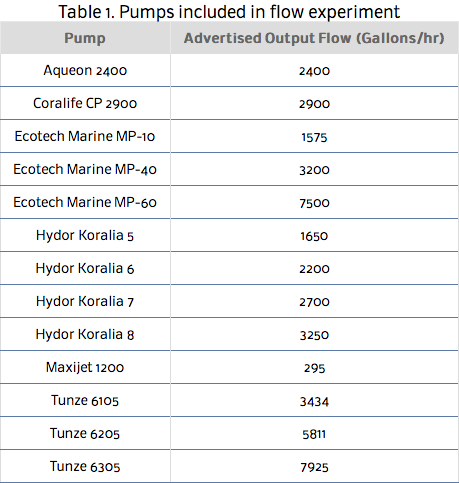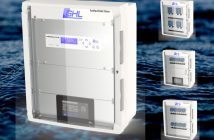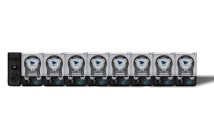By now I’m sure you’ve read the incredibly in-depth article covering measured flow output of various propeller-based water pumps over on Advanced Aquarist. For those of you who haven’t, here’s a quick rundown. The study was conducted by Michael Sandford, William Straka, and Sanjay Joshi with the main objective being to develop a method to more accurately measure water flows rates of various aquarium propeller pumps. Previous methods of measurement relied heavily on equations based on propeller fin measurements and pump rotational rates to calculate the theoretical flow rate. Additional methods of flow measuring consisted of simple bag-fill tests where, as its name implies, a bag of a certain volume was filled with water from the pump being observed. The testers would note how long it took to fill the bag to volume, and the flow rates were calculated. Understanding the intense complexity of water movement and the issues with commonly used testing methods, the group of researchers set out to develop a newer and more accurate way to measure water pump flow, and the results have been quite surprising.
Before we get into those surprising results, we must first describe the test and the instruments. A test tank of 350-gallons was set up and the tool used to measure the water flow was a SonTek/YSI 10-MHz ADV (Acoustic Doppler Velocimeter). This ADV is described as a “proven, accurate solution for high-precision, 3-axis (3D), velocity measurements in a wide variety of settings from the laboratory to the ocean”. It is an instrument used by various well-known colleges in both the lab and field, and is a suitable tool for measuring water flow from pumps as it doesn’t create back pressure or unusual conditions that a pump wouldn’t normally encounter. A strobe tachometer and Kill-A-Watt meter were also used to measure each pump’s rotational speed in RPMs and power consumption, respectively.
Thirteen brand name water pumps were tested, including all of the EcoTech Marine VorTech pumps currently available, multiple Hydor Koralia pumps, and the three most powerful Tunze Streams. The ADV was placed at different points in front of each water pump’s opening, measuring data at 5mm increments along both the vertical and horizontal axes. The results were compiled into a flow profile with each pump, and some of these results have caused quite a bit of stir. Some pumps exceeded their advertised flow rates, while others significantly underperformed. Based on the study, all of the EcoTech Marine VorTech pumps had flow rates that exceeded their advertised rates, as did the Hydor Koralia 5 and the Aqueon 2400. Surprisingly, each of the Tunze pumps were shown to consistently under perform, with the Tunze 6305 producing less than half of its advertised flow rate. What appeared to be an anomaly in the study was the fact that the Hydor Koralia 5 produced more water flow than a Koralia 6, and almost as much as a Koralia 7. No explanation was given for this anomaly.
The results of the test apparently even surprised the testers, as they sent the paper to Tunze prior to publication. Tunze conducted their own tests and apparently confirmed the results of this paper, but there’s no information given as to how they performed the independent test. We assume it was through the same or at least similar methods, but that remains to be seen at this point. Tunze has also released a press statement regarding the results of both studies, which we will discuss in a future article.
As for our opinion of the test, we feel there is a significant conflict of interest, despite the fact that Tunze has agreed to the test results. The reason for the conflict is EcoTech’s donation of the test equipment needed for the study and the fact that the person collecting the date was an EcoTech Marine intern.
“We would like to thank EcoTech Marine for providing the large aquarium and renting the equipment needed for the study. The work was performed under the technical guidance and consultation with Bill Straka and Sanjay Joshi of Penn State University. The data was collected by Mike Sandford during his summer internship at EcoTech Marine.”
I’m not at all trying to imply that EcoTech Marine or Mike Sandford are skewing the data, nor am I questioning the integrity of anyone associated with this test. However, when reading the article, you must keep in mind that the equipment was provided by EcoTech Marine and the results favor their products significantly. The VorTech pumps are great products, and I’ve owned several over the years, but any time you see a company essentially conduct a study of its own products alongside those of the competition and come out on top, you do have to question certain aspects of the study. The Tunze Streams are the single greatest competitor of the VorTech pumps, and to see them come out at the bottom is not only shocking, but turns into a PR nightmare for the company.
My only possible explanation for the significant difference in advertised versus actual flow rates for the Tunze Streams is the fact that they have a tube-like shroud protruding from the front of the pump. The VorTech pumps on the other hand, do not have a tubular shroud, but are instead wide open. On top of that, the Tunze shroud is seemingly longer than those of other pumps on the market, which further restricts flow and depresses water flow numbers. When describing previous and unreliable tests performed on older water pumps, the writers indicated that pumping water through a tube-like apparatus constrained water flow and created back pressure. For this reason, those tests were not accurate for propeller-based water pumps and it may serve as a reason behind the water flow differences in the Tunze pumps. This is of course speculation on our end, but given the design differences of each pump, it could serve as a reasonable explanation. This design may be an Achilles’ heel for Tunze, and a trip to the drawing board may be in order.
In closing, I wanted to again state that I do not doubt the test results or question the intentions of the testers. In fact, I applaud their efforts at expanding the understanding of water flow and the measuring of such parameters. Regardless of that, there is still a conflict of interest and I would honestly like to see more testing done, but this time by a completely disinterested third party. Even if the results were identical and the same equipment used, the study would be more readily accepted by the aquatic community and remove doubts from skeptical readers.










Pingback: The AquaNerd Blog Recap of 2011 | AquaNerd()
Pingback: Playtime With the Tunze 6105 Upgrades | AquaNerd()